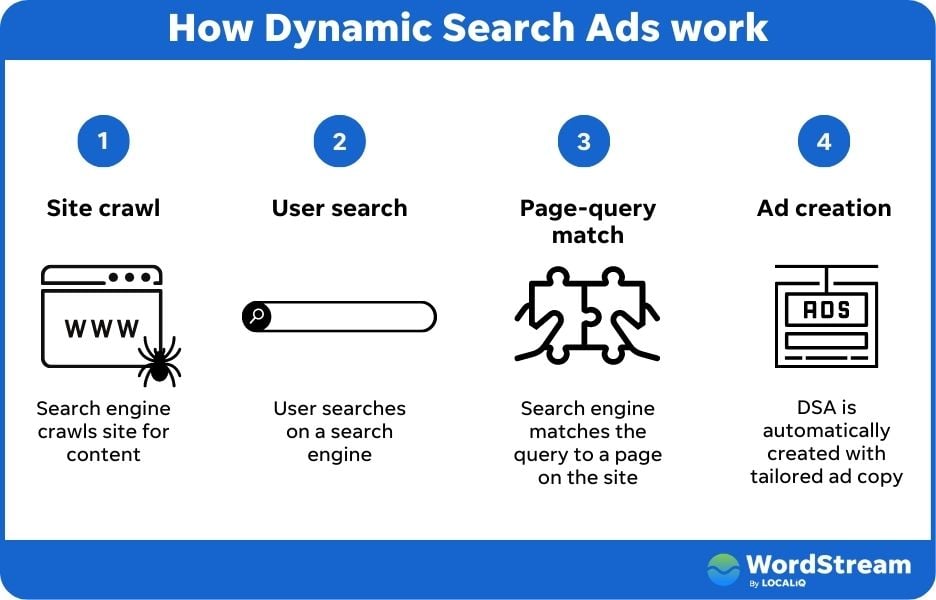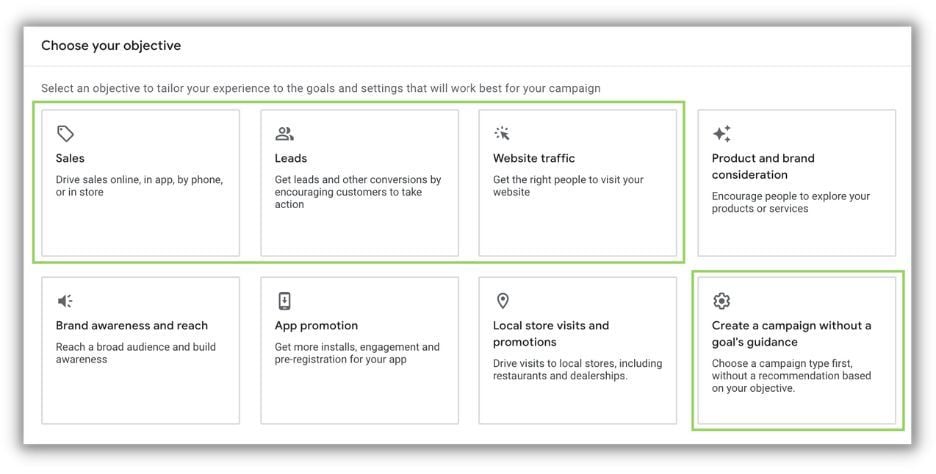Unlock the secrets to maximizing your online presence with Dynamic Search Ads – enhance your digital marketing strategy today!

Image courtesy of via DALL-E 3
Table of Contents
- Introduction to Dynamic Search Ads (DSAs)
- Setting Up Your Dynamic Search Ads
- Optimizing Your Dynamic Search Ads
- Understanding Performance Metrics
- Common Mistakes to Avoid with DSAs
- Advanced Tips for Boosting DSA Performance
- Real-Life Examples of Successful DSAs
- Tools and Resources for DSAs
- Conclusion and Summary
- Frequently Asked Questions (FAQs)
Introduction to Dynamic Search Ads (DSAs)
Dynamic Search Ads (DSAs) are a powerful tool that helps websites reach more people on search engines like Google. But what exactly are Dynamic Search Ads and how do they work? Let’s dive into the world of DSAs to understand how they can supercharge your online presence!
What Are Dynamic Search Ads?
Dynamic Search Ads, or DSAs for short, are a type of online advertisement that automatically adjusts its content to match what people are searching for on search engines. Imagine if your ad could change its message depending on what a person types into Google – that’s the magic of Dynamic Search Ads!
Why Are DSAs Important?
DSAs are crucial because they save you time and help you reach more potential customers. Instead of manually creating ads for every single search query, DSAs do the heavy lifting for you, showing relevant ads to the right audience at the right time. This means more visibility for your website and more chances for people to discover what you have to offer!
How Do DSAs Work?
Think of DSAs as your helpful assistant who knows exactly what people are searching for online. When someone types a query into a search engine, DSAs quickly scan your website and match the search query to the most relevant pages. Then, they automatically generate a unique ad that appears to the searcher. It’s like having a personalized ad creator working round the clock to connect you with potential customers!
Setting Up Your Dynamic Search Ads
When it comes to setting up your Dynamic Search Ads (DSAs) campaign, it’s important to follow a few key steps to ensure success. Below, we’ll walk you through how to create and set up your DSAs on Google Ads, choose the right target pages, and write effective ad copy to engage your audience.
Creating Your DSA Campaign
To begin setting up your DSAs, you’ll first need to create a new campaign in Google Ads specifically tailored for Dynamic Search Ads. This will allow you to customize your ad settings and target your desired audience effectively.
Choosing the Right Target Pages
Once your campaign is created, the next step is to select the pages on your website that you want Google to use for your DSAs. It’s crucial to choose pages that are relevant to your ads and are likely to attract your target audience.
Writing Effective Ad Copy
Writing compelling ad copy for your DSAs is essential to capturing the attention of your audience. Be sure to keep your copy clear, concise, and engaging. Highlight the unique selling points of your product or service to entice users to click on your ad.
Optimizing Your Dynamic Search Ads
When it comes to making your Dynamic Search Ads (DSAs) perform better, optimization is key. By implementing certain strategies, you can enhance the effectiveness of your ads and attract more relevant traffic to your website. Here are some tips to optimize your DSAs:

Image courtesy of via Google Images
Using Negative Keywords
Negative keywords are like filters for your ads. By specifying certain keywords that you don’t want your ads to show up for, you can prevent irrelevant clicks and save money on wasted ad spend. For example, if you sell only new cars, you might want to add “used” as a negative keyword to avoid showing up in searches for used cars.
Monitoring and Adjusting Bids
It’s essential to keep track of how much you’re willing to pay for clicks on your ads. By monitoring the performance of your ads and adjusting your bids accordingly, you can ensure that you’re getting the most out of your advertising budget. If a particular keyword is performing well, consider increasing your bid to capture more traffic.
Improving Ad Relevance
One of the most critical aspects of optimizing your DSAs is ensuring that your ads are relevant to what people are searching for. Make sure to use key phrases that align with the content of your target pages. The more relevant your ads are to the user’s search query, the more likely they are to click on them.
Understanding Performance Metrics
In order to know how well your Dynamic Search Ads (DSAs) are performing, you need to understand performance metrics. Performance metrics are like scorecards that show you how effective your ads are in reaching and engaging potential customers. Let’s dive into the key metrics to track, how to use Google Analytics, and how to interpret the data for better results.
Key Metrics to Track
When you’re running DSAs, there are several key metrics you should keep an eye on to assess their performance:
- Click-Through Rate (CTR): This metric tells you how many people clicked on your ad after seeing it. A higher CTR indicates that your ad is relevant and engaging.
- Conversion Rate: The conversion rate shows you how many people took the desired action after clicking on your ad, such as making a purchase or signing up for a newsletter.
- Cost Per Click (CPC): This metric reveals how much you’re paying for each click on your ad. Lower CPC means you’re getting more clicks for your budget.
Using Google Analytics
Google Analytics is a powerful tool that can help you track the performance of your DSAs. By integrating Google Analytics with your Google Ads account, you can gain valuable insights into how users interact with your website after clicking on your ads.
Interpreting Data
Once you have collected data on the performance metrics of your DSAs, it’s essential to interpret what the numbers mean. For example, if your CTR is low, you may need to adjust your ad copy to make it more compelling. If your conversion rate is high but your CPC is too high, you might want to focus on targeting more specific keywords to attract the right audience.
Understanding and analyzing the data from your DSAs can help you make informed decisions on how to optimize your ads for better performance.
By tracking key metrics, utilizing Google Analytics, and interpreting the data, you can improve the effectiveness of your DSAs and maximize your return on investment.
Common Mistakes to Avoid with DSAs
Dynamic Search Ads (DSAs) can be a powerful tool to boost your website’s performance, but there are common mistakes that people often make when using them. By avoiding these errors, you can ensure that your DSAs are running smoothly and effectively. Let’s take a look at some of the pitfalls to steer clear of:

Image courtesy of via Google Images
Ignoring Negative Keywords
One of the biggest mistakes you can make with DSAs is not utilizing negative keywords. Negative keywords are terms that you do not want your ads to show for. By neglecting to include these, you may end up wasting your budget on irrelevant clicks. Make sure to carefully identify and add negative keywords to your DSA campaigns to improve their targeting and performance.
Poorly Written Ad Copy
The ad copy you use for your DSAs plays a crucial role in engaging potential customers and driving conversions. If your ad copy is unclear, irrelevant, or poorly written, it can negatively impact your campaign’s performance. Take the time to craft compelling and concise ad copy that clearly conveys your message and entices users to click on your ads.
Inaccurate Targeting
Properly targeting your ads to specific pages and audiences is essential for the success of your DSAs. If your targeting is too broad or inaccurate, you may end up reaching the wrong people or wasting your budget on unqualified leads. Take the time to review and adjust your targeting settings to ensure that your ads are being shown to the right audience at the right time.
Advanced Tips for Boosting DSA Performance
When it comes to enhancing the performance of your Dynamic Search Ads (DSAs), there are some advanced strategies you can implement to take your campaigns to the next level. By incorporating these tactics, you can further optimize your DSAs for better results.
Dynamic Ad Targets
One way to boost the effectiveness of your DSAs is to use more specific dynamic ad targets. By honing in on particular segments of your website or products/services, you can tailor your ads to be even more relevant to what users are searching for. This increased relevance can lead to higher click-through rates and better overall performance.
Ad Scheduling
Another advanced tip for improving DSA performance is to utilize ad scheduling. By analyzing your data and determining when your target audience is most active or likely to convert, you can schedule your ads to run during peak times. This strategic approach can maximize the impact of your DSAs and ensure they are being displayed when they are most likely to drive results.
A/B Testing
Introducing the concept of A/B testing to your DSA campaigns can provide valuable insights into what resonates best with your audience. By creating multiple versions of your ads and testing them against each other, you can identify which ad elements generate the most engagement and conversions. This data-driven approach allows you to refine your ads for optimal performance and continuously improve your results over time.
Real-Life Examples of Successful DSAs
Let’s imagine a scenario where an online store that sells trendy sneakers wanted to increase their sales. By using Dynamic Search Ads (DSAs), they were able to reach a wider audience of potential customers who were searching for specific sneaker brands or styles. With DSAs, the store could automatically create relevant and engaging ads based on the content of their website, leading to a significant boost in sales.

Image courtesy of via Google Images
Example 2: Local Business Boost
Consider a local bakery that wanted to attract more customers within their neighborhood. By implementing DSAs, the bakery was able to promote their freshly baked goods to local residents searching for “delicious pastries near me” or “freshly baked bread nearby.” This targeted approach helped the bakery increase foot traffic and build a loyal customer base in their community.
Example 3: Service Industry Win
Now picture a plumbing service provider looking to expand their client base. Through DSAs, the company optimized their online presence by targeting specific keywords related to plumbing services and emergency repairs. By appearing in search results when potential customers were actively looking for plumbing assistance, the service provider saw a significant increase in inquiries and bookings, ultimately boosting their business.
Tools and Resources for DSAs
The Google Ads Planner is a valuable tool that helps in setting up Dynamic Search Ads effectively. It allows you to research keywords, plan your advertising campaigns, and analyze your ad performance. By using the Google Ads Planner, you can target the right audience and choose the best keywords to maximize the success of your DSAs.
Keyword Research Tools
Keyword research tools play a crucial role in finding the most relevant and high-performing keywords for your Dynamic Search Ads. These tools provide insights into search volumes, competition levels, and keyword variations. By utilizing keyword research tools, you can optimize your DSAs to attract more qualified traffic and improve your overall campaign performance.
Ad Customizers
Ad customizers are powerful tools that enable you to create dynamic and personalized ads for your audience. By using ad customizers, you can tailor your ad content based on user behavior, demographics, or specific search queries. This personalization can significantly enhance the relevance and engagement of your Dynamic Search Ads, leading to better performance and higher conversion rates.
Conclusion and Summary
In this blog post, we discussed the concept of Dynamic Search Ads (DSAs) and how they can help websites reach a larger audience more efficiently. We explored what DSAs are, why they are important, and how they work on search engines.

Image courtesy of via Google Images
Recap of Key Tips
We learned how to set up DSAs by creating a campaign, choosing target pages, and writing effective ad copy. Additionally, we discussed methods to optimize DSAs, including using negative keywords, monitoring and adjusting bids, and improving ad relevance.
Understanding performance metrics like click-through rate (CTR) and conversion rate, as well as interpreting data using tools like Google Analytics, was also covered. We highlighted common mistakes to avoid with DSAs, such as ignoring negative keywords and poorly written ad copy.
Final Thoughts
By implementing advanced tips like using dynamic ad targets, ad scheduling, and A/B testing, businesses can further enhance their DSA performance. Real-life examples of successful DSAs from e-commerce stores, local businesses, and service providers demonstrated how DSAs can drive growth and success.
Lastly, we listed tools and resources such as Google Ads Planner, keyword research tools, and ad customizers to aid in managing and optimizing DSAs effectively. Remember, optimization is key to maximizing the performance of your DSAs and achieving better results.
Want to turn these SEO insights into real results? Seorocket is an all-in-one AI SEO solution that uses the power of AI to analyze your competition and craft high-ranking content.
Seorocket offers a suite of powerful tools, including a Keyword Researcher to find the most profitable keywords, an AI Writer to generate unique and Google-friendly content, and an Automatic Publisher to schedule and publish your content directly to your website. Plus, you’ll get real-time performance tracking so you can see exactly what’s working and make adjustments as needed.
Stop just reading about SEO – take action with Seorocket and skyrocket your search rankings today. Sign up for a free trial and see the difference Seorocket can make for your website!
Frequently Asked Questions (FAQs)
What Are the Best Practices for DSAs?
When it comes to Dynamic Search Ads (DSAs), some best practices can help you optimize your performance. Firstly, make sure to regularly update your target pages to ensure relevance. This will help Google Ads match your ads to relevant search queries. Additionally, incorporating negative keywords can help eliminate irrelevant search terms, improving the overall efficiency of your DSAs. Lastly, monitoring your campaign regularly and refining your ad copies based on performance data can enhance your results over time.
How Often Should I Monitor My DSAs?
Monitoring your Dynamic Search Ads (DSAs) on a regular basis is crucial for their success. Checking in on your campaign daily or at least a few times a week can help you catch any issues or opportunities early on. By monitoring your DSAs frequently, you can see what’s working well and what needs adjustment, allowing you to optimize your ads for better performance continuously.
Can I Use DSAs for Small Businesses?
Dynamic Search Ads (DSAs) can be a beneficial tool for small businesses looking to increase their online presence and reach their target audience effectively. By using DSAs, small businesses can save time on manual keyword research and ad creation, allowing Google Ads to dynamically generate ads based on website content. This can help small businesses attract more potential customers and grow their online visibility without the need for extensive digital marketing resources.







